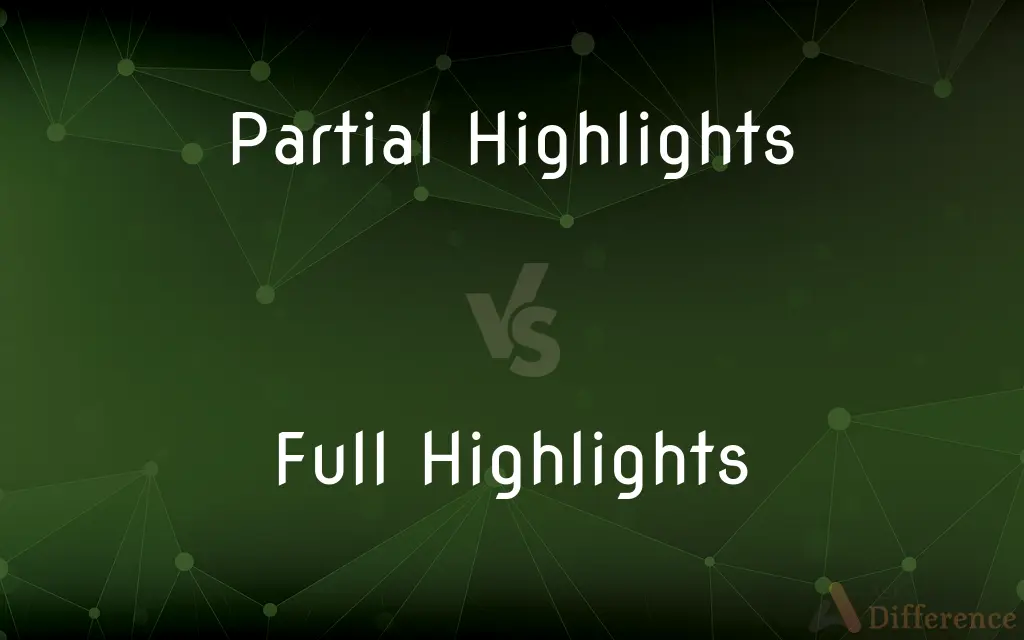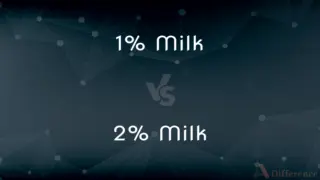Partial Highlights vs. Full Highlights — What's the Difference?
By Tayyaba Rehman — Published on January 29, 2024
Partial highlights involve coloring sections of hair, usually around the face, for a subtle look, while full highlights involve highlighting hair in every section, offering a more dramatic change.

Difference Between Partial Highlights and Full Highlights
Table of Contents
ADVERTISEMENT
Key Differences
Partial highlights are a hair coloring technique where highlights are applied to specific areas of the hair, usually focusing on the top layer or around the face. This method is used to create subtle changes in hair color, adding dimension and depth without a complete color overhaul. Full highlights, conversely, involve applying highlights throughout the entire head of hair, offering a more uniform and comprehensive change in hair color.
The process of partial highlights is less time-consuming and often more budget-friendly compared to full highlights. It's ideal for those seeking a natural-looking enhancement or those new to hair coloring. Full highlights require more time and effort, as they involve more sections of hair. This technique is suitable for those desiring a significant color transformation or an all-over lighter look.
Partial highlights can be a good choice for people with shorter hairstyles or those who want to experiment with color without commitment. The technique can be used to frame the face or emphasize certain haircuts. Full highlights, however, work well on all hair lengths and types, offering a complete and vibrant refresh of the hair's appearance.
Maintenance for partial highlights is generally lower compared to full highlights. Since they blend more with the natural hair color, root regrowth is less noticeable, extending the time between salon visits. Full highlights require more frequent touch-ups to maintain the overall consistency of color, especially for those with fast-growing hair or significant color contrast between their natural hair and highlights.
Partial highlights are versatile and can be used to trial a new color or add subtle nuances to the hair. They can easily be built upon in future salon visits for more comprehensive color changes. Full highlights are a commitment to a bolder color change and require more consistent care and maintenance to keep the hair looking vibrant and healthy.
ADVERTISEMENT
Comparison Chart
Coverage
Specific areas, usually top layer or face-framing
Entire head of hair
Time and Effort
Less time-consuming, simpler
More time-consuming, comprehensive
Ideal For
Subtle changes, natural enhancement
Dramatic, all-over color change
Maintenance
Lower, less frequent touch-ups
Higher, more frequent touch-ups
Impact on Look
Natural, subtle enhancement
Vibrant, uniform color transformation
Compare with Definitions
Partial Highlights
They offer a less drastic change and more natural look.
Partial highlights were perfect for her first hair coloring experience.
Full Highlights
They create a significant, uniform color change.
Full highlights transformed her look with a bold, blonde makeover.
Partial Highlights
Partial highlights add color to certain sections of hair.
She chose partial highlights to subtly brighten her face.
Full Highlights
Requires more frequent salon visits for maintenance.
She schedules regular appointments to maintain her full highlights.
Partial Highlights
Less maintenance compared to full highlights.
She loved her partial highlights for their easy upkeep.
Full Highlights
Suitable for a dramatic and noticeable color transformation.
Her full highlights made her hair look entirely different and vibrant.
Partial Highlights
Ideal for experimenting with color on a smaller scale.
Partial highlights allowed her to test the new color without a full commitment.
Full Highlights
Ideal for those wanting an all-over lighter hair appearance.
She chose full highlights to achieve an overall lighter hair color.
Partial Highlights
Focuses on the top layer or specific areas of the hair.
She got partial highlights just around her face for a sun-kissed look.
Full Highlights
Full highlights involve coloring strands throughout the entire head.
She went for full highlights for a complete summer-ready look.
Common Curiosities
Can full highlights work on very short hair?
Yes, but the effect may be more subtle compared to longer hair.
Are partial highlights cheaper than full highlights?
Generally, yes, since they involve less work and use less color.
Which is better for a natural look?
Partial highlights are better for a more natural, subtle enhancement.
Are full highlights damaging to hair?
They can be, due to more extensive coloring, but proper care minimizes damage.
What's the main difference between partial and full highlights?
Partial highlights target specific areas, while full highlights cover the entire head.
How often do partial highlights need touch-ups?
Less frequently than full highlights, often every 2-3 months.
How long does it take to apply full highlights?
It varies, but typically takes longer than partial highlights, often several hours.
Is there a big price difference between the two?
Yes, full highlights are generally more expensive due to more extensive work.
Are partial highlights good for gray coverage?
They can blend some grays but aren't as effective as full highlights for complete coverage.
Can I switch from full to partial highlights easily?
Yes, you can transition to partial highlights during your next coloring session.
Do partial highlights fade faster?
Not necessarily; fade rate depends more on hair type and aftercare.
Can I have lowlights with full highlights?
Yes, combining lowlights with full highlights can add depth and dimension.
Can I achieve an ombre effect with full highlights?
Yes, full highlights can be used to create an ombre effect, especially when focused on the ends.
Do partial highlights work with all hair colors?
Yes, they can be tailored to complement any natural hair color.
Will full highlights look too drastic if I have dark hair?
It can be a significant change, so it's important to consult with your stylist.
Share Your Discovery

Previous Comparison
1% Milk vs. 2% Milk
Next Comparison
Verbal Communication vs. Written CommunicationAuthor Spotlight
Written by
Tayyaba RehmanTayyaba Rehman is a distinguished writer, currently serving as a primary contributor to askdifference.com. As a researcher in semantics and etymology, Tayyaba's passion for the complexity of languages and their distinctions has found a perfect home on the platform. Tayyaba delves into the intricacies of language, distinguishing between commonly confused words and phrases, thereby providing clarity for readers worldwide.













































